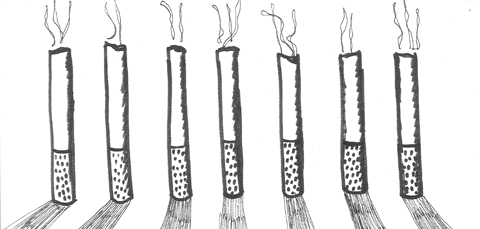
This article is a part of our October focus on Institutions – you can access more content from this issue here
By Bronwyn Naylor
A number of Australian corrections systems have announced that they will be banning smoking in prisons. The Northern Territory has already implemented a total ban, as have New Zealand, some US states and most provinces in Canada. Bans are also proposed in the UK. As a UK tabloid newspaper reported, “Lags are set to be stopped from lighting up fags”. Is this a rights issue? If so, whose rights are at stake?
The picture
Around four times more people smoke in prison compared to the general community.In 2012, 84 per cent of prisoners entering Australian prisons were smokers, and 80 per cent left as smokers. Some quit smoking whilst in prison, and other groups increased their rate of smoking.
Smoking in prison is therefore a problem for the health of the prisoners who smoke, as well as the staff and non-smoking prisoners who are exposed to second-hand smoke.
Smoking is also a significant part of prison life for prisoners who smoke. It is a social practice, a means of relaxation and stress relief, a rare exercise of choice, a form of currency, and “a symbol of freedom in a group with few rights and privileges”.
… people go to prison as the punishment for a crime of which they have been convicted. They do not go to prison to have further punishment imposed, and they do not lose their rights as human beings …
Restrictions on smoking
Most prisons in Australia now limit smoking to the prisoner’s cell and to outdoor areas. Consistent with community practice, smoking indoors (other than the prisoner’s cell, which is characterised as his or her ‘home’) is generally prohibited. Most prisons offer programs to help prisoners quit smoking, and some provide nicotine patches and other forms of nicotine replacement. Prisoners, however, highlight the stresses of prison life that can lead to relapsing into smoking, such as security ‘lockdowns’ that keep prisoners in their cells and prevent access to activities.
The drive for a total ban on smoking has come from occupational health and safety concerns for staff and fears of litigation by non-smoking prisoners exposed to smoke. These reflect the important right to safety in the workplace for staff, and to safety and health for non-smoking prisoners in their state-imposed place of detention.
Smoking bans and rights of prisoners
What about prisoners who smoke? A total ban on smoking significantly affects their lives. It prevents them from engaging in an activity that is lawful in the community and which provides (at least) pleasure and a small degree of personal freedom in an otherwise highly-controlled environment. Unlike staff, or people in the community, they can’t ‘step out for a smoke’. A ban makes their smoking illegal and subject to punishment. Any breach of the rules can lead to the imposition of fines and loss of privileges, and being subject to disciplinary proceedings may pose risks to parole eligibility.
People in prisons should be free to make unhealthy decisions, within limits, just as the rest of us can.
It should be remembered that it is official corrections policy in Australia and in most developed countries that people go to prison as the punishment for a crime of which they have been convicted. They do not go to prison to have further punishment imposed, and they do not lose their rights as human beings other than as needed to maintain the security of the prison and of their imprisonment. A rights-based approach would therefore require that, unless smoking is a risk to the security of the prison, a prisoner should be able to smoke.
This is not to claim that there is a ‘human right to smoke’. However prisoners do have rights, under international and domestic human rights instruments, to equal treatment and respect as human beings and to respect for privacy and home life. Prisons inevitably restrict the scope for choice, but limitations on autonomy must not extend beyond what is necessary for security. People in prisons should be free to make unhealthy decisions, within limits, just as the rest of us can.
The banning of smoking in places of detention has been the subject of international case law based on the equivalent of Article 17 of the ICCPR, to which Australia is a signatory, and which is also embodied in the rights instruments of Victoria and the ACT. This states that “[n]o one shall be subjected to arbitrary or unlawful interference with his privacy, family, home or correspondence”.
Not all cases have been successful, but in August 2013 a Scottish Court declared unlawful a complete smoking ban at a secure psychiatric hospital. The Court stated that the right to privacy and home life meant having your choices respected, even if “morally reprehensible”:
“If you are an adult, the state cannot interfere with your choices in the private sphere except for weighty reasons to do with the protection of others and the good of the community as a whole.”
The judge observed that, although the right can be restricted, this was limited to “interventions which are ‘necessary in a democratic society … for the protection of health or morals’: it is not a warrant for lifestyle fascism”. The New Zealand High Court in July 2013 similarly held that a total smoking ban in prison was unlawful, on the basis that the corrections legislation required a sentence of imprisonment to be administered in a humane manner, and “[f]orcing prisoners into nicotine withdrawal is not humane.”
A total ban is unnecessarily coercive for a cohort compelled to live in the prison, with limited choices about the regime under which they live. Requiring ‘healthy’ practices in such an environment is inappropriately punitive. This may of course be part of its appeal amongst some segments of the community, whose view of prison is that, as reported in a UK tabloid recently, “Absolutely NO luxuries should be allowed.”
Consequences of a ban on smoking in prisons
A total ban in a Queensland prison in 1997 led to riots. Indeed, a recent UK newspaper headline warned, “Prison smoking ban sparks fears of riots among officers and campaign groups”.
“Banning smoking is different from quitting”
Australian researchers report that smoking is “bound up in the routine” of prison, used to manage stress and boredom, a “comfort during transfers between facilities and when making court appearances”, and “the only drug left” when everything else has been taken away. Supports for the challenging step of quitting smoking are not always (or adequately) provided.
Bans on smoking have additional, predictable and negative consequences. Banning smoking may produce a black market in cigarettes, corruption, standovers, and trading sex for tobacco. A lawyer visiting prisoners on the Isle of Man, where smoking is banned, reported prisoners smoking “anything they can find out of desperation from fluff to pubic hair”, and a ban on teabags when prisoners began smoking the tealeaves mixed with nicotine patches.
A ban requires increased policing and enforcement of yet another illegal substance, against prisoners, staff and visitors. Staff who smoke also find a total ban challenging.
It has been argued here that smoking bans have been justified on the basis of the health of staff, and the risk of harm to, and litigation by, non-smoking prisoners. However if there were also an interest in prisoner health, the evidence is that total bans are ineffective in stopping prisoners smoking longer term:
“Banning smoking is different from quitting. Requiring people to give up smoking while in prison will undoubtedly have health benefits but these benefits are lost if they recommence smoking after release. There is no evidence that simply banning smoking is effective in reducing smoking rates over the long term.”
Indeed, the likelihood is that many prisoners will continue to smoke, albeit illegally. A study of the effect of the bans in the US, for example, found that 76 per cent of prisoners continued to smoke in prison after the bans were imposed, and 97 per cent smoked once released.
Conclusions
It is not argued here that prisoners should be able to smoke anywhere they wish. Balancing competing rights justifies restrictions on the place and time of smoking, in prison as in the community. This would entail bans on smoking indoors, as is currently the case, with provision for smoking and non-smoking cells, but with specific smoking areas available outdoors. Where prisoners did not have daily access to such outdoor spaces, indoor spaces should be made available.
We need to deal with smoking as drug dependence, with equivalent health care principles in prison as in the wider community. Free access to nicotine replacements, to Quitline counselling, to health information and to positive reinforcement are essential. As argued above, since prisoners do not lose their rights other than those necessarily lost by imprisonment, and since total smoking bans cannot be justified on security grounds, the approach to managing smoking and exposure to second hand smoke in a prison should be that which applies in the community as a whole. As in the community, partial restrictions will be appropriate and more effective than total prohibition.
Programs to help prisoners quit smoking need to recognise the unique stresses of the prison environment and provide alternative activities, employment and education to support the cessation of smoking. We cannot however ignore the underlying question: if prisons are used as punishment and not for punishment, why do so many prisoners rely on tobacco to cope with their incarceration?
Bronwyn Naylor is from the Law Faculty at Monash University and is lead investigator on an ARC-funded project on protecting human rights in prisons and other places of detention, ‘Applying Human Rights in Closed Environments‘.
Click here to read her Right Now article The Slap: Corporal Punishment and Children’s Human Rights.




